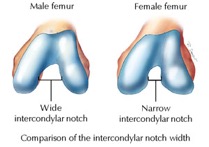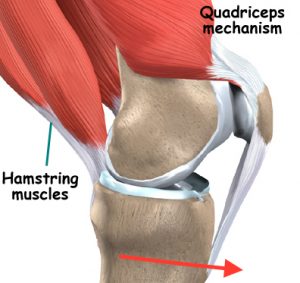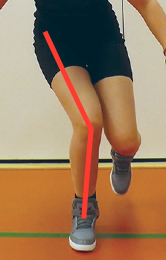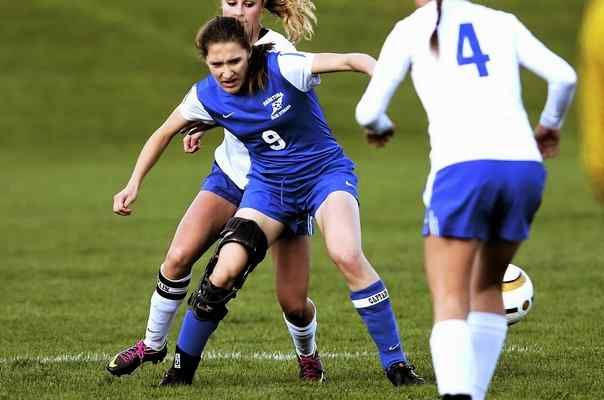Female athletes rupture their anterior cruciate ligament (ACL) more frequently than males…nearly 6-8 times more!
The most common sports in which female athletes suffer ACL injuries are soccer and basketball, primarily because of the jumping, landing, and quick direction-changes involved in these sports.
To explain why so many of our young female athletes are enduring such a devastating season-ending injury, we break it down into four categories: Anatomy, Strength, Biomechanics, and Hormones
Before going any further, let’s be clear that males experience torn ACLs as well (all too often, in fact), and the injury is not any easier for males to recover from compared to females. In all cases, there are common variables – some modifiable, some not – that lead to this life changing knee injury, which inevitably impacts the athlete’s future.
Anatomy
Females typically have a wider pelvis, which means the upper legs will have a more angled alignment, known as a “Q angle” and as shown in the image below. A larger Q angle leads to an increased angle at the knees and greater demand on the stabilizing ligaments of the knees, especially the ACL and MCL (medial collateral ligament).

The intracondylar notch is a space in the knee, through which the anterior and posterior cruciate ligaments cross (ACL, PCL). A correlation between a narrow intracondylar notch (more common in females) and ACL tears, suggests that a narrow notch could be a risk factor for ACL injury.

Thirdly, a smaller ACL may be more prone to injury, compared to an ACL of larger size. A study involving male and female surgical candidates found that the ACL of an injured knee was significantly smaller in size than the opposite knee and compared to uninjured knees; therefore, females and males with smaller ACLs could potentially have a naturally higher risk of injury.
The anatomical risk factors are non-modifiable and generally unidentifiable through screening.
Strength
Muscular strength and endurance around the knee, especially around the hips and core, can help to protect the knees from stressful loads on the ligaments. Young female athletes tend to have more weakness through the hips and core, which directly contributes to their higher rate of injury.
Many young female athletes, even those who are highly skilled in their sport, have weakness of the gluteal and hamstrings muscles on the back-side of the legs, and they compensate with very strong quadriceps muscles on the front of the thighs. The term “quad-dominant” describes a muscle-firing pattern that relies too heavily on the quadriceps muscles, rather than engaging supportive muscles from the posterior chain (gluteals, hamstrings, etc). As a result, force from the quadriceps places extra stress on the ACL and may lead to traumatic or chronic breakdown of the ACL.

On an optimistic note, strength and endurance deficits are modifiable risk factors that affect both males and females, and can be improved with a sport-specific strengthening program.
Biomechanics

A classic movement pattern typical for young female athletes and highly associated with ACL ruptures is a knee valgus position. Knee valgus alignment is evident when the knee is positioned inward toward midline of the body, rather than remaining in a direct line from the hip to the foot. This valgus position initiates tension on the ACL and MCL in the knee, and leaves it susceptible to a major injury.
When landing from a jump, decelerating, or quickly changing directions, a knee valgus tendency is most pronounced, as shown in the image above.
Females have a greater tendency to collapse into a knee valgus position, while males tend to bend the knees and hips more and maintaining better alignment from the hips to the feet.
Altered mechanics is the leading predictor of ACL injury. The good news is that mechanics can be improved with training!
Together, strength and biomechanics are integrated and referred to as “neuromuscular control.” When trained properly, neuromuscular control is the most effective variable for reducing the risk of ACL injury by 50-80% and improving balance, agility, and motor control.1,2,3,4
Hormones
A study by the National Athletic Trainers Association suggests that hormones put females at a higher risk for ACL injury. Hormone differences between males and females, and possibly the length of exposure to those hormones during a monthly cycle, could contribute to ligament laxity and potential for injury.5,6
Educating parents, coaches, and athletes about the risk for female athletes will hopefully promote early, proactive intervention and reduce the frequency of ACL injuries.
Rather than relying on luck, know which areas you can improve in and pave your way to a long and prosperous athletic career!

References
- Rössler R, Junge A, Bizzini M, et al. A multinational cluster randomised controlled trial to assess the efficacy of ’11+ Kids’: a warm-up programme to prevent injuries in children’s football. Sports Med 2017.
- Rössler R, Donath L, Bizzini M, et al. A new injury prevention programme for children’s football–FIFA 11+ Kids–can improve motor performance: a clusterrandomised controlled trial. J Sports Sci 2016;34:549–56.
- Lopes TJA, Simic M, Myer GD, et al. “The Effects of Injury Prevention Programs on the Biomechanics of Landing Tasks: A Systematic Review With Meta-analysis.” American Journal of Sports Medicine. 46(6) 2018. 1492-1499.
- Sadoghi P, von Keundell A, Vavken P. “Effectiveness of anterior cruciate ligament injury prevention training programs.” Journal of Bone and Joint Surgery Am. 94(9) 2012 pg. 769-76.
- Voskanian N. “ACL Injury prevention in female athletes: review of the literature and practical considerations in implementing an ACL prevention program.” Current Review Musculoskeletal Medicine. Jun 2013. 158-163.
- Slauterbeck, James R, Fuzie, Stephen F., Smith, Michael P., et al. “The Menstrual Cycle, Sex Hormones, and Anterior Cruciate Ligament Injury.” Journal of Athletic Training, 2002; Jul-Sep; 37(3):275-278.



